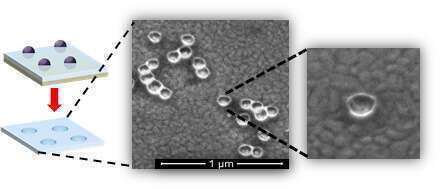
Polymers and electropolymerization for the selective detection of nanoparticles: Nanoparticles imprinted matrices (NAIM)
The selective recognition of nanoparticles (NPs) has been developed by us for the last years. With the benefits that NPs bring due to their unique properties that are a result of their size, they also pose a threat. Indeed, nanotoxicology is a new discipline, which deals with the adverse effects of NPs. Evidently, the detection of NPs requires the development of appropriate tools. These interactions are affected by the core, size, shape, and stabilizing shell of the NPs. Hence, speciation of NPs, is becoming of utmost importance.
We have continuously been developing a new concept for the selective recognition and detection of NPs termed NPs imprinted matrices (NAIM) [1-6]. It is analogous to the molecularly imprinted polymer (MIP) concept, where removal of the imprinted NPs forms complementary cavities capable of selective recognition of the NPs.
We will present a few new systems by which we show how NPs can be imprinted inside a matrix. What the conditions for their removal and reuptake are, and what makes the matrix selective and sensitive towards the originally imprinted NPs. The formation of the matrix is accomplished by electropolymerization, which enables the excellent control of the thickness of the layer. This is a key factor for achieving efficient NAIMs.
So far, we have shown that the NAIM can selectively recognize NPs that differ in their size and thickness, and the nature of their stabilizing shell. Moreover, we have used matrices made of a wide variety of monomers such as aryldiazonium, sol-gel, and phenols. The lecture will focus on the future of this exciting field, which is still in its infancy.

1. Bruchiel-Spanier, N.; Dery, L.; Tal, N.; Dery, S.; Gross, E.; Mandler, D., Nano Research 2019, 12 (2), 265-271.
2. Shahar, T.; Feldheim, G.; Marx, S.; Mandler, D., Nanoscale 2018, 10 (37), 17593-17602.
3. Bruchiel-Spanier, N.; Giordano, G.; Vakahi, A.; Guglielmi, M.; Mandler, D., ACS Applied Nano Materials 2018, 1 (10), 5612-5619.
4. Hitrik, M.; Pisman, Y.; Wittstock, G.; Mandler, D., Nanoscale 2016, 8 (29), 13934-13943.
5. Bruchiel-Spanier, N.; Mandler, D., Chemelectrochem 2015, 2 (6), 795-802.
6. Kraus-Ophir, S.; Witt, J.; Wittstock, G.; Mandler, D., Angewandte Chemie-International Edition 2014, 53 (1), 294-298.
Powered by Eventact EMS